Abstract
In the present experimental work, the energy and exergy for single slope passive solar still with different basin water depths are experimentally investigated under the Baghdad climate condition. The analysis is performed using the governing equations formulated according to the first and second laws of thermodynamics. Compared to solar still with 1 cm water depth, the obtained results indicated that raising the water depth to 2 and 3 cm caused an appreciable drop in water basin temperature, and high levels of water basin reduction were about 4% and 9%, respectively, from 8:00 a.m. to 14:00 p.m., which significantly affects heat and mass transfer and ultimately hinders further water productivity. The maximum evaporation and convection heat transfer coefficients are found (32 W/m2·k) and (2.62 W/m2·k), respectively, while the maximum productivity of solar still is found to be 1468.84 mL/m2 with 1 cm water depth. Conversely, stills with 2 and 3 cm water depth, exhibit an increment of the daily exergy efficiency after 14:00 p.m., this increment was the most for the still with 3 cm water depth. Therefore, we have concluded that the still with 1 cm of water depth attained the highest water productivity, while the still with 3 cm of water depth attained the best exergy efficiency with no additional costs.
1. Introduction
As the climate changes, many remote regions, especially in the Middle East, are facing a severe shortage of freshwater resources. Iraq, with a population of about 40 million people, will face multiple water challenges, including a severe shortage of drinking water [1,2,3]. According to United Nation reports, the water flow of the Tigris and Euphrates rivers will be reduced by more than 25% and 50%, respectively, by 2025. As a result of reducing water flows, the water salinity will increase. To address this issue, many researchers have worked to use renewable energy sources, such as solar distillation technology (solar still), to desalinate salt water [4,5,6,7,8,9,10]. The essential factors influencing the solar still system performance are the solar radiation intensity, type of solar still, design of solar still, sunshine duration, climate conditions, and geographic differences [9,10,11,12,13,14]. A detailed experimental investigation of 10 homemade solar stills at glass inclination angles of 10, 15, 20, 25, 30, 35, 40, 45, 50, and 55 degrees under Iraqi climate conditions was performed by Azooz et al. [15]. The findings demonstrate that the inclination angles between 30 and 35 have the least water productivity and performance, while the inclination angles between 20 and 25 have the best water productivity and cost-effectiveness. Another experimental investigation concerning the influence of absorber plate surface shape on the stepped solar still thermal performance and water productivity [16]. The obtained data showed that utilising the convex absorber plate resulted in higher average water productivity than using the flat absorber plate. According to Kabeel et al. [17], the still’s energy performance is strongly affected by basin water depth. They experimentally studied the influence of water depth on the energy performance of the pyramid solar still painted with TiO2 nano black paint under Egyptian climate conditions. They claimed that as the depth of the water decreases, the temperature of the basin water rises, resulting in higher water productivity. Moreover, their results indicated that the best productivity was found at a water depth of 1 cm. Manokar et al. [18] experimentally confirmed that varying the water depth in pyramid solar still has a significant influence on energy performance and water productivity. Their results showed that at 1 cm water depth, maximum daily thermal efficiency was 28.50 and 26.17%, while the maximum productivity was 3.72 and 3.27 kg/m2 with and without insulation, respectively. An experimental investigation was performed by Hoque et al. [19] using a pilot-scale solar still with a variable amount of basin water (from 3 to 4) litres and salt concentration (from 2000 to 8000) ppm under the climate conditions of Bangladesh. The results show that the maximum water productivity can be achieved with the optimum basin water amount (3.5) litres at which the water depth is equal to 1.6 cm. Moreover, they found an inverse relationship between water productivity and salt concentration. Based on the above-detailed investigations of literature, it is obvious that the productivity of water from the still is highly dependent on the temperature difference , in which the water depth plays an important role. Although energy evaluation has been studied and analysed intensively, it is only recently that the exergy evaluation has gained significant attention for evaluating the performance of various solar desalination systems. Exergy analysis, which is formulated according to the second. The law of thermodynamics is a perspective approach for the performance evaluation, design, and optimization of desalination systems. Torchia-Nunez et al. [20] conducted a theoretical exergy analysis of simple configuration solar still. They reported that exergy efficiencies of the basin plate, water basin, and the overall system are 12.9%, 6%, and 5%, respectively, for the same input exergy. The exergy analysis of the still coupled with PCM as a thermal storage material was evaluated by Asbik et al. [21]. The findings revealed an increase in the productivity of water and a decrease in exergy efficiency due to using the storage materials. Another experimental investigation used an external solar water heater coupled with the still to evaluate the effect of outer and inner glass cover temperatures on the exergy efficiency and water productivity [22]. They reported that when (Tgo ≠ Tgi), the water productivity decreases by up to 4.4% and 7.5% for passive and active solar stills, respectively while increasing the water depth and the number of collectors led to a decrease in the thermal efficiency. Based on the above-detailed investigations of literature, it is obvious that the overall energy and exergy efficiencies and productivity of water from the solar still strongly depend on the basin liner, basin water, and glass temperatures, in which the water depth plays an important role. As per the author’s knowledge, the influence of water depth on the energy and exergy performance of single slope passive solar still according to the climate conditions of Baghdad city has not been reported yet in the literature. Therefore, the present work aims to investigate experimentally the influence of the water depth on the energy and exergy performance of a single slope passive solar still. This work is devoted to better understanding the performance behaviour when the water depth ranges from 1 to 3 cm.
2. Experimental Setup
The vivid and schematic descriptions of the solar still under investigation are shown in Figure 1 and Figure 2. The solar still has a one-square-meter projected area and is made up of several parts listed in the same figure. The basin liner (0.98 m × 0.48 m) is constructed of a 3 mm thick galvanised iron sheet and filled with salt water (with salinity up to 2000 ppm.) from the water tank via a non-return valve and mechanical floater. The basin liner is covered with a black material to improve the ability of solar energy absorption and then insulated from all sides with a fibreglass layer (k = 0.04 W/m·K) thickness of 0.01 m to minimise heat losses. The solar still is made of MDF wood and has dimensions of 1 m and 0.5 m in length and width, as well as 0.62 and 0.27 m in height for the large and small sides, respectively. Single transparent glass with a 4 mm thickness mounted on the top of the still is used as a cover for the still and also as a condenser surface. To make it airtight and to prevent any leakage, silicon rubber is used to close any gap between the still edges and the glass cover.
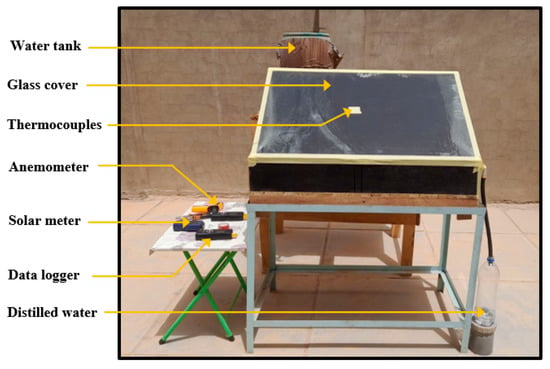
Figure 1.
Photograph view of the experimental solar still.
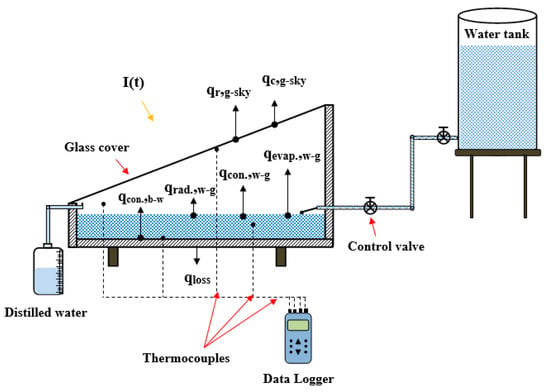
Figure 2.
Schematic description of the experimental solar still.
A graded plasticware beaker is used to measure the distilled water obtained.
3. Experimental Procedure and Uncertainty Analysis
The solar still is tested under the Baghdad climate conditions (latitude and longitude coordinates are 44.45° E, 33.309253° N) and installed in a southerly direction to maximise the solar intensity amount incident on the still. Experimental tests are performed in three cases during May 2022 on three days 17, 18, and 19 with close values of solar radiation to clarify the effect of the basin’s water depth on energy, exergy, and water productivity. An (sm 206) akozon solar radiation meter type with (±0.6%) in accuracy is utilised to record the solar radiation incident on the still. The anemometer (UNI-T/ ut 363) type (from 0 to 30 m/s measuring range) with (±5%) accuracy is utilised to measure wind speed. Five calibrated type (K) thermocouples, implanted in different locations, are used to measure the temperatures of the basin liner, basin water, glass (inner and outer surface), and vapour region. They are connected directly to a digital thermometer of type (TC9815) and have an accuracy of (0.01%). To estimate the uncertainties of the measured data, Equation (1) [23] has been adopted, where UR represents the variable uncertainty, X = X (v1, v2, v3 to vn), and U1, U2, U3 to Un represent the uncertainties of the independently measured variables. Table 1 shows the measured variable uncertainties.

Table 1.
Measured variable uncertainties.
4. Mathematical Modeling
4.1. Energy Analysis
In the still, the energy obtained by saltwater equals the amount of energy lost via convection, radiation, and evaporation heat transfer processes between glass and water basins plus the energy gained by saltwater [24].
where the heat transfer rates by convection, radiation, and evaporation can be calculated using the following relationships.
The coefficients of heat transfer by convection, radiation, and evaporation between glass and basin water can be calculated using the following relations [25]:
where, Pgl, and Pw is the vapour pressure at glass and water temperatures respectively, can be calculated using the following relations:
The heat transfer rates by convection and radiation between ambient and glass can be calculated using the following relations:
The coefficients of heat transfer by convection and radiation between ambient and glass can be calculated using the following relations:
The still’s daily thermal efficiency is determined as follows [26]:
where hfg is the water latent heat of vaporization in J/kg estimated by Equation (17) as follows [27]:
4.2. Exergy Analysis
Exergy analysis of the still is performed by employing the governing equations formulated based on the second law of thermodynamics. Consequently, the exergy balance’s general form can be expressed as described as follows [21]:
where Ex,dest refers to the consumed or destroyed exergy amount, Ex,out. and Ex,in. refers respectively exergy amounts exiting and entering (losses and/or useful) via still boundaries, and calculated by [26,27]:
where It is the solar radiation incident on the still, Ab is the basin area, and Tsun is the sun’s temperature, taken as 6000 K. The exergy efficiency is thus calculated as the proportion of the still’s output to its input, which can be expressed as follows:
5. Results and Discussion
Experiments are conducted on clear sky days (17–19 May 2022) with close solar radiation values to provide a fuller understanding of solar still performance with water depths ranging from 1 to 3 cm. The daily variations in the solar radiation and ambient, glass, and water basin temperatures for the three considered cases are plotted in Figure 3, Figure 4 and Figure 5. As time progressed, the solar radiation and all recorded temperatures increased until they achieved the maximum values at 13:00 p.m. Then, the behaviour is reversed, and they gradually decrease until sunset. For 1 cm water depth, the highest temperatures recorded were 61.73, 48.71, and 27.74 °C (at 13:00 p.m.) for water basin, glass, and ambient temperature, respectively. While it is 59.99, 47.38, and 26.69 °C for 2 cm, then 55.6, 45.42, and 27 °C for 3 cm water depth.
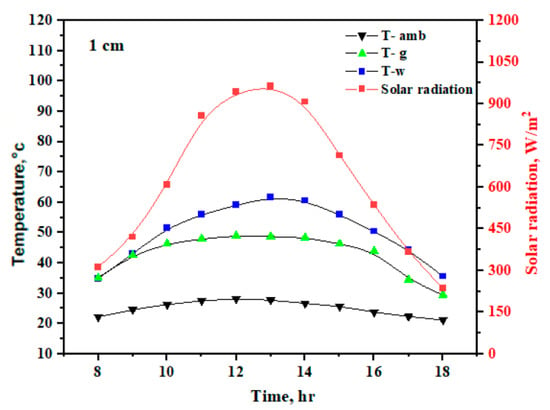
Figure 3.
Daily variations of temperature and solar intensity of the still with 1 cm water depth.
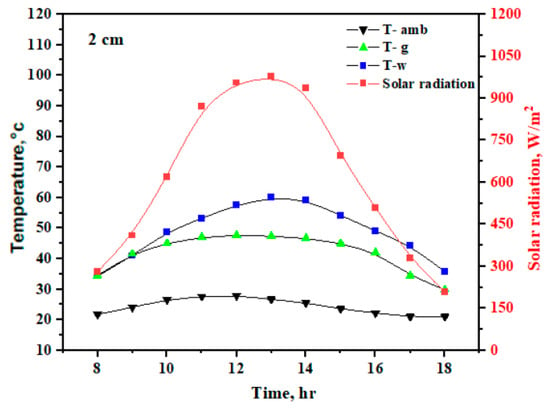
Figure 4.
Daily variations of temperature and solar intensity of the still with 2 cm water depth.
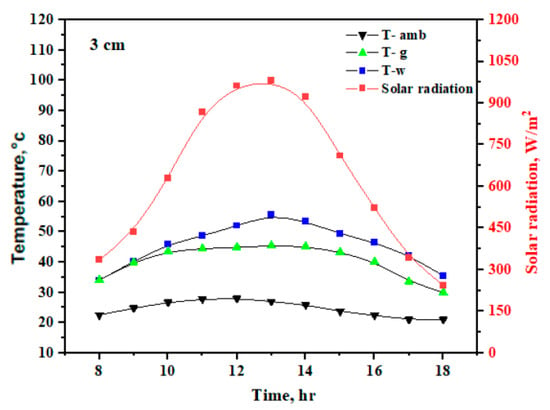
Figure 5.
Daily variations of temperature and solar intensity of the still with 3 cm water depth.
The daily variations of the basin’s water temperature of the still with a water depth ranging from 1 to 3 cm are plotted in Figure 6. From 8:00 a.m. to 14:00 p.m., the water temperature in the basin is higher at 1 cm than it is at 2 and 3 cm, and then it gradually drops. Rising the water depth from 1 to 2 cm caused a decrease in the basin’s water temperature of up to 4% (from 8:00 a.m. to 14:00 p.m.), and an increase of up to 2% (from 15:00 p.m. to 18:00 p.m.), which has a direct impact on the energy, exergy, and water productivity. Whereas raising the water depth to 3 cm caused a decrease in the basin’s water temperature of up to 9% (from 8:00 a.m. to 14:00 p.m.), and an increase of up to 3.5% (from 15:00 p.m. to 18:00 p.m.). This increase in the basin’s water temperature is due to the energy-storing ability of the water held in the basin.
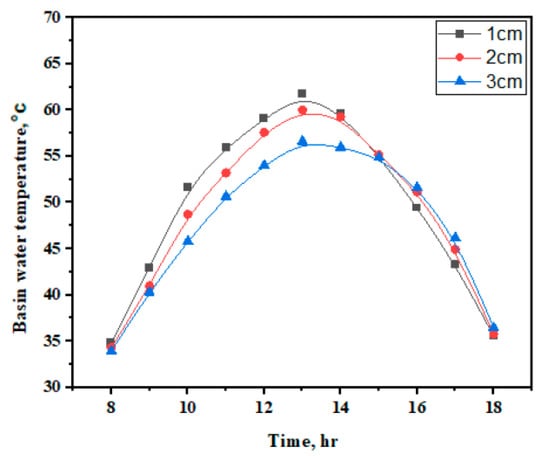
Figure 6.
Daily variations of water temperature with respect to time. The heat and mass transfer (inside the still) are largely affected by the water depth and basin water temperature depending on Equations (3)–(8). The daily variations in the heat transfer coefficients by convection and evaporation inside the still are depicted in Figure 7 and Figure 8. As seen from the figures, at various water depths the rate of heat transfer by evaporation is higher than the rate of heat transfer by convection under the same operating conditions. It is revealed that the still with 1 cm water depth gives the highest evaporation heat transfer coefficient (32 W/m2·k) at 13:00 p.m. and then decreases to (7.7 W/m2·k) at 18:00 p.m. While at 2 and 3 cm gives the highest evaporation heat transfer coefficient (between 29.3 and 24.5 W/m2·k) at 13:00 p.m. and then decreases to (between 7.76 and 8.18 W/m2·k) at 18:00 p.m. As a result, the evaporation process is the dominant heat transfer mechanism, and it is greatly affected by temperature differences between the basin water and the glass cover.
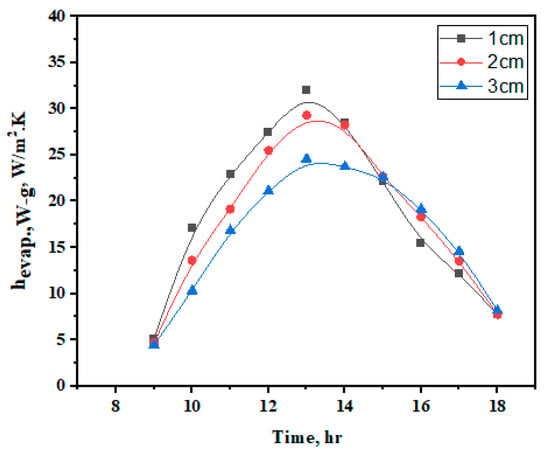
Figure 7.
Influence of water depth on heat transfer coefficient by evaporative.
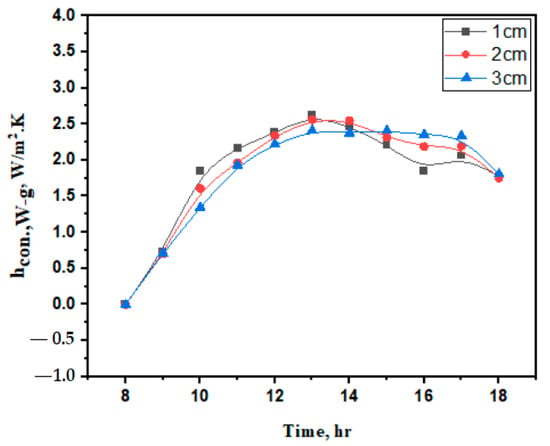
Figure 8.
Influence of water depth on heat transfer coefficient by convective.
Figure 9 shows the energy efficiency of the still with time for the three considered cases. It is observed that energy efficiency follows the same trend as water basin temperatures (from 8:00 p.m. to 14:30 p.m.), and then the curve’s behaviour is reversed at about 15:00 p.m. Energy efficiency strictly depends on water productivity and solar radiation. As the basin’s water temperature reduces, the evaporation rate declines, and therefore the energy efficiency decreases. The decrease in the energy efficiency with 2 cm water depth is about 25% and about 54.3% with 3 cm, compared to the still with 1 cm water depth. A comparison of the results obtained with the results of similar distillation systems according to thermal efficiency and water yield is presented in Table 2.
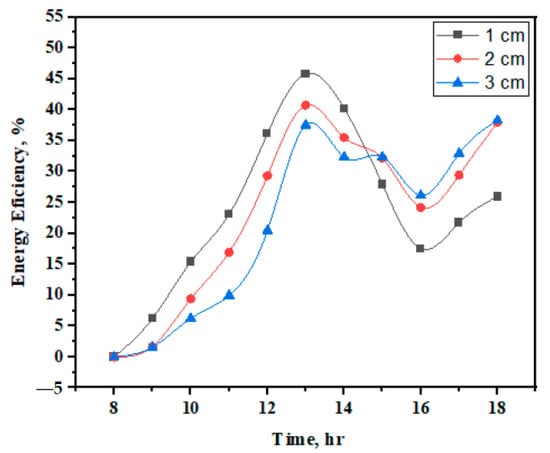
Figure 9.
Energy efficiency with respect to time.

Table 2.
Comparison with similar distillation systems.
Based on Equations (18)–(20), the hourly input and output exergy rates are depicted in Figure 10. It is depicted that the output energy rates increase when solar radiation increases. According to Figure 9, the output exergy rates at water depths of 2 and 3 cm decrease away from the output exergy rate obtained at water depths of 1 cm. The output exergy dropped by about 13% and 36%, respectively, compared to the still with 1 cm of water depth at 13:00 p.m. Figure 11 gives the exergy efficiency evolutions for the three considered cases. Generally, the exergy efficiency trend increases progressively after 11:00 a.m. and reaches its maximum value at 13:00. The maximum exergy efficiencies for the three considered cases are found to be about 32.3, 31.4, and 26.0. At about 16:00 p.m., the behaviour of the curves is reversed. It is obvious that the exergy efficiency with 3 cm of water depth was higher than others. This behaviour was due to the energy-storing ability of the water held in the basin, which led to an increase in the evaporation rate.
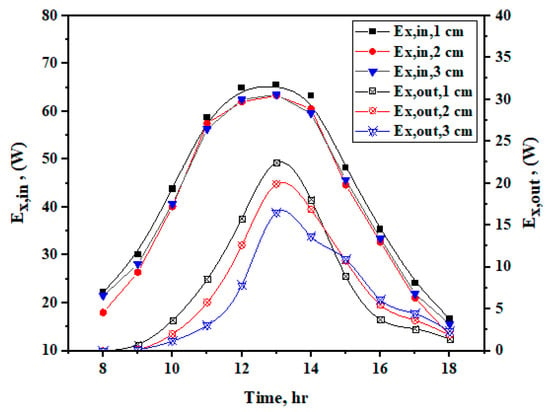
Figure 10.
Hourly input and output exergy rates with respect to time.
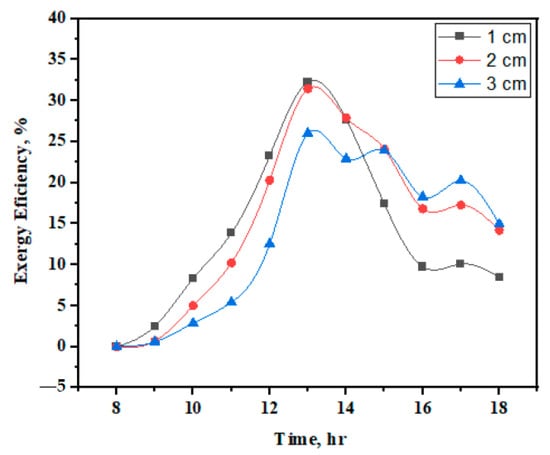
Figure 11.
Exergy efficiency with respect to time.
The accumulated variations in water productivity from solar still with a water depth ranging from 1 to 3 cm are plotted in Figure 12. As time progresses, water production from the solar still with 1 cm water depth increases until they achieve the maximum values (339 mL/m2) at 13:00 p.m. Then, the behaviour is reversed, and they gradually decrease until sunset. As a result, the accumulated productivity is found to be 1468.84 mL/m2. Increasing the water depth from 1 cm to 2, and 3 cm caused a decrease in hourly water productivity of up to 20% (from 8:00 a.m. to 14:00 p.m.) and an increase of up to 17.2% percent (from 15:00 p.m. to 18:00 p.m.). While increasing the water depth to 3 cm caused a decrease in hourly water productivity up to 47.7%, (from 8:00 a.m. to 14:00 p.m.), and an increase of 33% (at or from 15:00 p.m. to 18:00 p.m.). At 2 and 3 cm, the accumulated productivity is found to be 1357.54 and 1223.82 mL/m2, which is 8.2% and 20% less than the solar still at 1 cm.
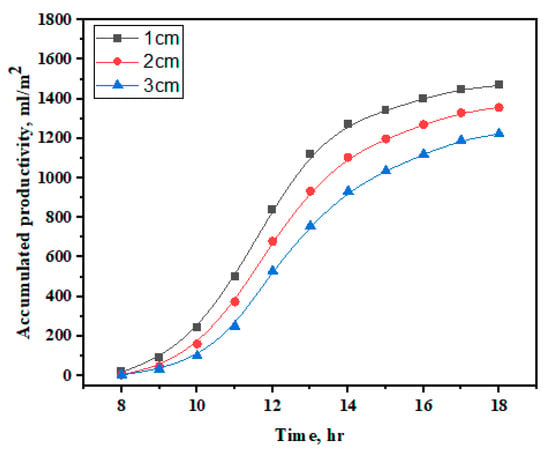
Figure 12.
Accumulated water productivity with respect to time from the three considered cases of the still.
6. Conclusions
An experimental investigation has been successfully developed to analyse the effect of water depth on the energy, exergy, and water productivity of a single slope passive solar still located in the Baghdad centre. The decrease in depth of basin water has managed to increase the basin water temperature, thus increasing evaporation and convection heat transfer processes. The average rate of evaporation heat transfer coefficient of a still with 1 cm is found at 17.4%, which is higher than the evaporation heat transfer coefficient of a still with 2 and 3 cm by around 15.1–4.8%. This led to a decrease in water productivity and energy efficiency of stills with 2 and 3 cm in comparison to a still with 1 cm. The average energy efficiency of stills with 1 cm is 23.6%, which is higher than the energy efficiency of a still with 2 and 3 cm by around 9.3–1.1%. In terms of exergy efficiency, the still with 2 cm attained the most elevated exergy efficiency, followed by the still with 1 cm and then the still with 1 cm. Overall, it can be concluded that the still with 1 cm is the most acceptable option in terms of energy efficiency and water productivity as it is ranked highest in all obtained parameters. To further understand the performance behaviour, the basin water depth (below 1 cm) should be checked.
Author Contributions
Conceptualization, H.A.A.W.; Data curation, H.Q.A.K.; Formal analysis, H.Q.A.K. and W.A.K.A.-M.; Investigation, H.Q.A.K., H.A.A.W. and W.A.K.A.-M.; Methodology, H.Q.A.K. and W.A.K.A.-M.; Resources, H.Q.A.K.; Software, H.A.A.W.; Supervision, F.A. and B.E.; Visualization, F.A.; Writing—original draft, H.Q.A.K.; Writing—review & editing, W.A.K.A.-M. All authors have read and agreed to the published version of the manuscript.
Funding
This research received no external funding.
Acknowledgments
We acknowledge support by the Deutsche Forschungsgemeinschaft (DFG) German Research Foundation and the Open Access Publishing Fund of the Technical University of Darmstadt. The authors would like to also thank the University of Technology-Iraq.
Conflicts of Interest
The authors declare no conflict of interest.
Nomenclature
| I | Solar radiation, W/m2 |
| P | Pressure of vapour, Pa. |
| h | Heat transfer coefficient, W/m2∙K. |
| T | Temperature, C. |
| A | Area, m2. |
| Cp | Specific heat, kJ/kg.K. |
| UR | Uncertainty, - |
| m | Amount of water productivity, mL/m2. |
| V | Wind speed, m/s. |
| hfg | Latent heat of vaporization, J/kg. |
| Abbreviations | |
| con. | Convection. |
| rad. | Radiation. |
| evap. | Evaporation. |
| gl | Glass. |
| w | Water. |
References
- Elaiwi, H.A.; Hasan, K.; Al-Hadithi, M. Management of Natural Iraqi Water Resources, Aims and Challenges. In IOP Conference Series: Materials Science and Engineering; IOP Publishing: Bristol, UK, 2020; Volume 881, p. 012181. [Google Scholar]
- Younes, M.M.; Abdullah, A.S.; Essa, F.A.; Omara, Z.M.; Amro, M.I. Enhancing the wick solar still performance using half barrel and corrugated absorbers. Process Saf. Environ. Prot. 2021, 150, 440–452. [Google Scholar] [CrossRef]
- Al-Maliki, W.A.K.; Al-Hasnawi, A.G.T.; Abdul Wahhab, H.A.; Alobaid, F.; Epple, B. A Comparison Study on the Improved Operation Strategy for a Parabolic trough Solar Power Plant in Spain. Appl. Sci. 2021, 119, 576. [Google Scholar] [CrossRef]
- Toosi, S.S.A.; Goshayeshi, H.R.; Heris, S.Z. Experimental investigation of stepped solar still with phase change material and external condenser. J. Energy Storage 2021, 40, 102681. [Google Scholar] [CrossRef]
- Al-Maliki, W.A.K.; Hadi, A.S.; Al-Khafaji, H.M.; Alobaid, F.; Epple, B. Dynamic Modelling and Advanced Process Control of Power Block for a Parabolic Trough Solar Power Plant. Energies 2022, 151, 29. [Google Scholar] [CrossRef]
- Akram, A.H.; Hisham, A.H.; Mohammed, H.J. Experimental investigation of modified solar still coupled with high-frequency ultrasonic vaporizer and phase change material capsules. Case Stud. Therm. Eng. 2021, 28, 101531. [Google Scholar]
- Al-Maliki, W.A.K.; Alobaid, F.; Keil, A.; Epple, B. Dynamic Process Simulation of a Molten-Salt Energy Storage System. Appl. Sci. 2021, 11, 11308. [Google Scholar] [CrossRef]
- Essa, F.A.; Abdullah, A.S.; Omara, Z.M. Improving the performance of tubular solar still using rotating drum–Experimental and theoretical investigation. Process Saf. Environ. Prot. 2021, 148, 579–589. [Google Scholar] [CrossRef]
- Khafaji, H.Q.; Abdul, W.H.A.; Alsaedi, S.S.; Al-Maliki, W.A.K.; Alobaid, F.; Epple, B. Thermal Performance Evaluation of a Tubular Heat Exchanger Fitted with Combined Basket–Twisted Tape Inserts. Appl. Sci. 2022, 12, 4807. [Google Scholar] [CrossRef]
- Kumar, A.H.; Venkateswaran, H.; Kabeel, A.E.; Chamkha, A.; Athikesavan, M.M. Ravishankar Sathyamurthy, and Kamalakannan Kasi. Recent advancements, technologies, and developments in inclined solar still—A comprehensive review. Environ. Sci. Pollut. Res. 2021, 28, 35346–35375. [Google Scholar] [CrossRef]
- Al-Maliki, W.A.K.; Khafaji, H.Q.; Abdul Wahhab, H.A.; Al-Khafaji, H.M.; Alobaid, F.; Epple, B. Advances in Process Modelling and Simulation of Parabolic Trough Power Plants: A Review. Energies 2022, 15, 5512. [Google Scholar] [CrossRef]
- Terekhov, V.I.; Gorbachev, M.V.; Khafaji, H.Q. Heat and mass transfer during ethanol evaporation on the walls of a flat channel at forced convection of humid air. Int. J. Heat Mass Transf. 2020, 156, 119821. [Google Scholar] [CrossRef]
- Le, T.H.; Pham, M.T.; Hadiyanto, H.; Pham, V.V.; Hoang, A.T. Influence of Various Basin Types on Performance of Passive Solar Still: A Review. Int. J. Renew. Energy Dev. 2021, 10, 789–802. [Google Scholar] [CrossRef]
- Tuly, S.S.; Rahman, M.S.; Sarker, M.R.I.; Beg, R.A. Combined influence of fin, phase change material, wick, and external condenser on the thermal performance of a double slope solar still. J. Clean. Prod. 2021, 287, 125458. [Google Scholar] [CrossRef]
- Azooz, A.A.; Younis, G.G. Effect of glass inclination angle on solar still performance. J. Renew. Sustain. Energy 2016, 8, 033702. [Google Scholar] [CrossRef]
- Goshayeshi, H.R.; Safaei, M.R. Effect of absorber plate surface shape and glass cover inclination angle on the performance of a passive solar still. Int. J. Numer. Methods Heat Fluid Flow 2020, 30, 3183–3198. [Google Scholar] [CrossRef]
- Kabeel, A.; Sathyamurthy, R.; Sharshir, S.W.; Muthumanokar, A.; Panchal, H.; Prakash, N.; Prasad, C.; Nandakumar, S.; El Kady, M. Effect of water depth on a novel absorber plate of pyramid solar still coated with TiO2 nano black paint. J. Clean. Prod. 2019, 213, 185–191. [Google Scholar] [CrossRef]
- Manokar, A.M.; Taamneh, Y.; Kabeel, A.E.; Winston, D.P.; Vijayabalan, P.; Balaji, D.; Sathyamurthy, R.; Sundar, S.P.; Mageshbabu, D. Effect of water depth and insulation on the productivity of an acrylic pyramid solar still–An experimental study. Groundw. Sustain. Dev. 2020, 10, 100319. [Google Scholar] [CrossRef]
- Hoque, A.; Abir, A.H.; Shourov, P.K. Solar still for saline water desalination for low-income coastal areas. Appl. Water Sci. 2019, 9, 104. [Google Scholar] [CrossRef]
- Torchia-Nunez, J.C.; Porta-Gandara, M.A.; Gortari, J.G.C. Exergy analysis of a passive solar still. Renew. Energy 2008, 33, 608–616. [Google Scholar] [CrossRef]
- Asbik, M.; Ansari, O.; Bah, A.; Zari, N.; Mimet, A.; El-Ghetany, H. Exergy analysis of solar desalination still combined with heat storage system using phase change material (PCM). Desalination 2016, 381, 26–37. [Google Scholar] [CrossRef]
- Tiwari, G.N.; Dimri, V.; Chel, A. Parametric study of an active and passive solar distillation system: Energy and exergy analysis. Desalination 2009, 242, 1–18. [Google Scholar] [CrossRef]
- Holman, J.P. Experimental Methods for Engineers; McGraw-Hill: New York, NY, USA, 1978. [Google Scholar]
- Feilizadeh, M.; Estahbanati, M.R.K.; Ahsan, A.; Jafarpur, K.; Mersaghian, A. Effects of water and basin depths in single basin solar stills: An experimental and theoretical study. Energy Convers. Manag. 2016, 122, 174–181. [Google Scholar] [CrossRef]
- Dashtban, M.; Tabrizi, F.F. Thermal analysis of a weir-type cascade solar still integrated with PCM storage. Desalination 2019, 279, 415–422. [Google Scholar] [CrossRef]
- Fernández, J.; Chargoy, N. Multi-stage, indirectly heated solar still. Sol. Energy 1990, 44, 215–223. [Google Scholar] [CrossRef]
- Petela, R. Exergy of undiluted thermal radiation. Sol. Energy 2003, 74, 469–488. [Google Scholar] [CrossRef]
- Panchal, H. Performance investigation on variations of glass cover thickness on solar still: Experimental and theoretical analysis. Technol. Econ. Smart Grids Sustain. Energy 2016, 1, 7. [Google Scholar] [CrossRef] [Green Version]
- Khalifa, A.N. Exergy analysis of modified solar still. Int. J. Therm. Environ. Eng. 2015, 10, e149–e154. [Google Scholar]
Publisher’s Note: MDPI stays neutral with regard to jurisdictional claims in published maps and institutional affiliations. |
© 2022 by the authors. Licensee MDPI, Basel, Switzerland. This article is an open access article distributed under the terms and conditions of the Creative Commons Attribution (CC BY) license (https://creativecommons.org/licenses/by/4.0/).